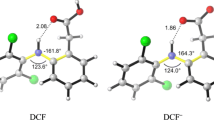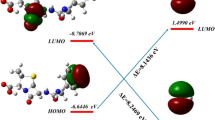Abstract
In this work, the density functional theory is used to study the local reactivity of cephalexin (CLX) to radical attack and explain the mechanism of the reaction between CLX and hydroxyl radical attack leading to degradation byproducts. The reaction between •OH and CLX is supposed to lead to either an addition of a hydroxyl radical or an abstraction of a hydrogen. The results showed that the affinity of cephalexin for addition reactions increases as it passes from the gas to the aqueous phase and decreases as it passes from the neutral to the ionized form. Thermodynamic data confirmed that OH addition radicals (Radd) are thermodynamically favored over H abstraction radicals (Rabs). The ecotoxicity assessments of CLX and its byproducts are estimated from the acute toxicities toward green algae, Daphnia, and fish. The formation of byproducts is safe for aquatic organisms, and only one byproduct is harmful to Daphnia.
Graphical abstract










Similar content being viewed by others
Data availability
The datasets generated and/or analyzed during the current study are available from the corresponding author on reasonable request.
Code availability
Gaussian 16 program package: G16W Full Version, 32-Bit, Rev: A.03 Front: 1.1. Version: Multiprocessor. GaussView6 for Windows, Rev: 6.0.16, 32-bit. V32108462166828W-4627 N. ECOSAR Class Program (Free Ware).
References
Bailey A, Walker A, Hadley DG (1971) James, Cephalexin. A new oral antibiotic, Torax 20:15–19
He J, Zhang Y, Guo Y, Rhodes G, Yeom J, Li H, Zhang W (2019) Photocatalytic degradation of cephalexin by ZnO nanowires under simulated sunlight: kinetics, influencing factors, and mechanisms. Environ Int 132:105105. https://doi.org/10.1016/j.envint.2019.105105
Estrada AL, Li Y-Y, Wang A (2012) Biodegradability enhancement of wastewater containing cefalexin by means of the electro-Fenton oxidation process. J Hazard Mater 227:41–48. https://doi.org/10.1016/j.jhazmat.2012.04.079
Benarab N and Fangninou FF (2020) The issues of Antibiotics: Cephalexin Antibiotic as emerging environment contaminant. Int J Sci Res Publ 10:306–318. https://doi.org/10.29322/IJSRP.10.02.2020.p9843
Ikehata K, JodeiriNaghashkar N, Gamal El-Din M (2006) Degradation of aqueous pharmaceuticals by ozonation and advanced oxidation processes: a review, Ozone Sci. Eng. 28:353–414. https://doi.org/10.1080/01919510600985937
Mandal T, Maity S, Dasgupta D, Datta S (2010) Advanced oxidation process and biotreatment: their roles in combined industrial wastewater treatment. Desalination 250:87–94. https://doi.org/10.1016/j.desal.2009.04.012
Stefan MI (2017) Advanced oxidation processes for water treatment: fundamentals and applications. IWA publishing. https://doi.org/10.2166/9781780407197_0297
Kanakaraju D, Glass BD, Oelgemöller M (2018) Advanced oxidation process-mediated removal of pharmaceuticals from water: a review. J Environ Manage 219:189–207. https://doi.org/10.1016/j.jenvman.2018.04.103
Cao J, Ren Q, Chen F, Lu T (2015) Comparative study on the methods for predicting the reactive site of nucleophilic reaction. Sci China Chem 58:1845–1852. https://doi.org/10.1007/s11426-015-5494-7
Yang W, Mortier WJ (1986) The use of global and local molecular parameters for the analysis of the gas-phase basicity of amines. J Am Chem Soc 108:5708–5711
Droguett C, Salazar R, Brillas E, Sirés I, Carlesi C, Marco JF, Thiam A (2020) Treatment of antibiotic cephalexin by heterogeneous electrochemical Fenton-based processes using chalcopyrite as sustainable catalyst. Sci Total Environ 740:140154. https://doi.org/10.1016/j.scitotenv.2020.140154
Bansal P, Verma A (2018) N, Ag co-doped TiO2 mediated modified in-situ dual process (modified photocatalysis and photo-Fenton) in fixed-mode for the degradation of cephalexin under solar irradiations. Chemosphere 212:611–619. https://doi.org/10.1016/j.chemosphere.2018.08.120
Wu H, Feng Q, Yang H, Alam E, Gao B, Gu D (2017) Modified biochar supported Ag/Fe nanoparticles used for removal of cephalexin in solution: characterization, kinetics and mechanisms. Colloids Surfaces A Physicochem Eng Asp 517:63–71. https://doi.org/10.1016/j.colsurfa.2017.01.005
Perea LA, Palma-Goyes RE, Vazquez-Arenas J, Romero-Ibarra I, Ostos C, Torres-Palma RA (2019) Efficient cephalexin degradation using active chlorine produced on ruthenium and iridium oxide anodes: role of bath composition, analysis of degradation pathways and degradation extent. Sci Total Environ 648:377–387. https://doi.org/10.1016/j.scitotenv.2018.08.148
Coledam DAC, Pupo MMS, Silva BF, Silva AJ, Eguiluz KIB, Salazar-Banda GR, Aquino JM (2017) Electrochemical mineralization of cephalexin using a conductive diamond anode: a mechanistic and toxicity investigation. Chemosphere 168:638–647
Antonin VS, Aquino JM, Silva BF, Silva AJ, Rocha-Filho RC (2019) Comparative study on the degradation of cephalexin by four electrochemical advanced oxidation processes: evolution of oxidation intermediates and antimicrobial activity. Chem Eng J 372:1104–1112. https://doi.org/10.1016/j.cej.2019.04.185
Guo W, Wang H, Shi Y, Zhang G (2010) Sonochemical degradation of the antibiotic cephalexin in aqueous solution, Water Sa. 36. https://doi.org/10.4314/wsav36i5.61998
Alalm MG, Tawfik A, Ookawara S (2015) Degradation of four pharmaceuticals by solar photo-Fenton process: kinetics and costs estimation. J Environ Chem Eng 3:46–51
Becke AD (1996) Density-functional thermochemistry. IV. A new dynamical correlation functional and implications for exact-exchange mixing. J. Chem. Phys. 104:1040–1046. https://doi.org/10.1063/1.470829
Ho J, Ertem MZ (2016) Calculating free energy changes in continuum solvation models. J Phys Chem B 120:1319–1329. https://doi.org/10.1021/acs.jpcb.6b00164
Yamana T, Tsuji A (1976) Comparative stability of cephalosporins in aqueous solution: kinetics and mechanisms of degradation. J Pharm Sci 65:1563–1574. https://doi.org/10.1002/jps.2600651104
Roy RK, Pal S, Hirao K (1999) On non-negativity of Fukui function indices. J Chem Phys 110:8236–8245. https://doi.org/10.1063/1.478792
Galano A, Alvarez-Idaboy JR (2009) Guanosine + OH radical reaction in aqueous solution: a reinterpretation of the UV-Vis data based on thermodynamic and kinetic calculations. Org Lett 11:5114–5117. https://doi.org/10.1021/ol901862h
An T, Gao Y, Li G, Kamat PV, Peller J, Joyce MV (2014) Kinetics and mechanism of • OH mediated degradation of dimethyl phthalate in aqueous solution: experimental and theoretical studies. Environ Sci Technol 48:641–648
Sanderson H, Johnson DJ, Wilson CJ, Brain RA, Solomon KR (2003) Probabilistic hazard assessment of environmentally occurring pharmaceuticals toxicity to fish, daphnids and algae by ECOSAR screening. Toxicol Lett 144:383–395. https://doi.org/10.1016/S0378-4274(03)00257-1
Al-Musawi TJ, Kamani H, Bazrafshan E, Panahi AH, Silva MF, Abi G (2019) Optimization the effects of physicochemical parameters on the degradation of cephalexin in sono-Fenton reactor by using Box-Behnken response surface methodology. Catal Letters 149:1186–1196
Legnoverde MS, Simonetti S, Basaldella EI (2014) Influence of pH on cephalexin adsorption onto SBA-15 mesoporous silica: theoretical and experimental study. Appl Surf Sci 300:37–42
Cinar SA, Ziylan-Yavaş A, Catak S, Ince NH, Aviyente V (2017) Hydroxyl radical-mediated degradation of diclofenac revisited: a computational approach to assessment of reaction mechanisms and by-products. Environ Sci Pollut Res 24:18458–18469. https://doi.org/10.1007/s11356-017-9482-7
Tavasol F, Tabatabaie T, Ramavandi B, Amiri F (2020) Design a new photocatalyst of sea sediment/titanate to remove cephalexin antibiotic from aqueous media in the presence of sonication/ultraviolet/hydrogen peroxide: Pathway and mechanism for degradation. Ultrason Sonochem 65:105062. https://doi.org/10.1016/j.ultsonch.2020.105062
Farcasiu D (1975) The use and misuse of the Hammond postulate. J Chem Educ 52:76. https://doi.org/10.1021/ed052p76
Guerra MMH, Alberola IO, Rodriguez SM, López AA, Merino AA, Alonso JMQ (2019) Oxidation mechanisms of amoxicillin and paracetamol in the photo-Fenton solar process. Water Res 156:232–240
Hsu MH, Kuo TH, Chen YE, Huang CH, Hsu CC, Lin AYC (2018) Substructure reactivity affecting the manganese dioxide oxidation of cephalosporins. Environ Sci Technol 52:9188–9195. https://doi.org/10.1021/acs.est.8b02448
K. Kümmerer, Pharmaceuticals in the environment: sources, fate, effects and risks, Springer Science & Business Media, 2008.
Funding
This study was financially supported by the General Directorate of Scientific Research and Technological Development (DGRSDT) of Algeria through the national research program (PRFU N° B00L01UN180120220001).
Author information
Authors and Affiliations
Contributions
R. Masmoudi: investigation, methodology, writing—original draft, writing—reviewing and editing. S. Khettaf: methodology, validation. A. Soltani: formal analysis, validation. A. Dibi: conceptualization, validation. L. Messaadia: software, formal analysis. M. Benamira: supervision, validation, writing—reviewing and editing.
Corresponding authors
Ethics declarations
Competing interests
The authors declare no competing interests.
Additional information
Publisher's note
Springer Nature remains neutral with regard to jurisdictional claims in published maps and institutional affiliations.
Rights and permissions
About this article
Cite this article
Masmoudi, R., Khettaf, S., Soltani, A. et al. Cephalexin degradation initiated by OH radicals: theoretical prediction of the mechanisms and the toxicity of byproducts. J Mol Model 28, 141 (2022). https://doi.org/10.1007/s00894-022-05121-y
Received:
Accepted:
Published:
DOI: https://doi.org/10.1007/s00894-022-05121-y




